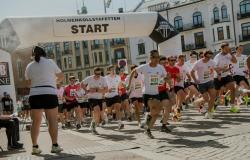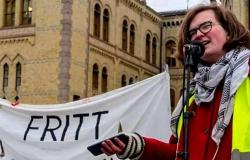The short version
- Thousands of civilians in Ukraine are locked up in prison-like camps by the Russian occupiers.
- Torture and humiliation are used systematically. The practice is in breach of the international law of war, according to a new report commissioned by the OSCE. The Norwegian expert Cecilie Hellestveit is one of three authors.
- The report will be presented to the OSCE in Vienna on Thursday. Hellestveit says that Norway must pay particular attention to how neighboring Russia treats civilians in a war zone.
View more
Torture and humiliation are used systematically, according to a new report on Russia’s violations of the international law of war.
– This is one of the darkest things I have worked on, says Cecilie Hellestveit to VG.
The Norwegian lawyer and expert on the rules of war is co-author of the report commissioned by the OSCE, the Organization for Security and Cooperation in Europe, of which Russia is also a member.
– The conditions for civilians in Russian prisoners of war are astonishingly bad and inhumane. In my opinion, there is a systematic violation of the Geneva Conventions on war victims, to which Russia has also joined, she says.
In recent months, Hellestveit has worked together with two other experts on a report on the treatment of civilians in the war zones in Ukraine.
The report will be presented on Thursday to the OSCE Permanent Council in Vienna.
– Systematic torture
There are no reliable estimates of how many civilians Russia has arbitrarily imprisoned since the 2022 invasion.
Hellestveit says that it is about several thousand people in areas in Ukraine that have been, or are still, occupied by Russia.
Ukrainian authorities have a preliminary list of 16,000 civilians who are missing, but some of them may have been killed in the war, or are in hiding.
The report describes a system that Russia has used in the areas where its forces have taken control:
– Russia has organized a process called filtering. The occupier uses lists of names of people who have been public employees or whom they consider to be enemies of Russia. They map out who may have the information they want, and who could potentially pose a threat to the occupier. These are often exposed to rough interrogations, says Hellestveit.
– Torture is used systematically. We can determine that, because the same methods are described from many different places, she adds.
– We have a witness description that the abbreviation for the Russian Federation has been scratched into the bare buttocks of a Ukrainian prisoner, she says.
The OSCE report
The OSCE has 57 member states, among them Russia and Ukraine. Next to the UN, this is one of the few organizations where Russia still has full rights.
Under a procedure known as the Moscow mechanism, a majority of countries can order reports on possible violations of international law.
Last winter, 45 countries, including Norway, joined forces to investigate the situation of civilian prisoners in the Russian-occupied areas of Ukraine. Cecilie Hellestveit was given the assignment together with Eline Steinerte from Latvia and Vera Bilkova from the Czech Republic.
The report is now ready and will be presented to the OSCE Council on Thursday afternoon. Then all member states – including Russia – will have the opportunity to comment on it.
View more
Sexual violence
According to the report, the three rapporteurs have received testimonies from civilian Ukrainians who have escaped Russian captivity, about methods used by the Russians.
Victims and family members testified to endless humiliation, shouting and threats.
The victims have told the report writers that they have been pushed, kicked and hit with various objects. They have received electric shocks, fingers have been cut.
They have testified about rape and sexual humiliation, that they largely refused medical treatment, and that many of them have been left in cold and dark cellars.
False confessions
– Russia uses to a small extent the very worst torture methods, those that take people’s lives, says Hellestveit.
She also describes how Ukrainians are forced to make false confessions on camera.
– Russia can use these confessions when it suits them. They can, for example, be used for later blackmail in order to obtain services for Russia, or in the case of threats that the confessions will be published. There may also be statements where people acknowledge that they have collaborated with the occupier – which means that you risk prosecution in Ukraine for treason, she says.
– All this is strictly prohibited according to the Geneva Conventions on what is legal in warfare, she adds.
The Geneva Conventions
All the world’s countries – including Russia and Ukraine – have ratified the four Geneva Conventions, which are the core of the international law of war.
The Fourth Geneva Convention of 1949 was a result of World War II, in which about half of the victims were civilians.
It states that civilians are not legal targets. Civilians in enemy custody must be respected. They must be protected against any form of violence and reprisal – no one must be held responsible for something they did not do.
If civilians are interned by the enemy, strict rules for the prisoner of war apply. Among other things, they must be able to maintain contact with their relatives.
Source: Norwegian Red Cross
View more
Talked to victims
Hellestveit and the two other experts traveled around Ukraine earlier this spring. From morning until late at night, they have interviewed war victims, authorities and organizations in order to obtain information which they now present in the OSCE report.
The Norwegian expert tells VG about how Russia has proceeded in Mariupol, where the occupier gained control after long and hard battles inside the city’s huge steelworks in the months after the occupation in 2022.

– Those who had not fled east or west were ordered to different types of filtration centers outside the city. They were checked and interrogated to determine whether they would be loyal to Russia. Those who were considered potentially disloyal were not allowed back in, but were exiled or interned. But those who passed the filtering gained access to the city and the new homes that Russia has built up, she explains.
Legal void
She says that Russia has created what they believe is a legal vacuum:
Russia has formally incorporated the regions of eastern Ukraine as Russian territory. Thus, Russia believes that this part of the Geneva Convention does not concern Russia.
– We recognize this pattern from other occupying powers, she says.
– At the same time, it looks as if Russia is following up the provisions on prisoners of war to a greater extent, obviously because it is in their own interest to be able to exchange and get back their own soldiers who have been captured by Ukraine, she continues.

So far in the war, there have been more than 50 agreements on the exchange of prisoners of war – combatant soldiers – between Ukraine and Russia.
– Russia’s entire treatment of the Ukrainians in the war zone appears orchestrated and well planned. There are no coincidences here, but a carefully planned system where Russia exploits loopholes they themselves create, and which gives them a large room for maneuver.
– These are rules to protect war victims, and when they are broken in such a systematic way, there are very serious consequences for civilians, says the Norwegian expert.
Maximum pressure
Hellestveit hopes that the report will now contribute to the outside world putting maximum pressure on Russia to change the way the country treats Ukrainian civilians.
Last year she co-authored an OSCE report on the children who were taken out of the occupied territories to Russia. The report criticized Russia for abducting children who were offered to Russian families for adoption.
– Russia flatly rejected the contents of the report. But later, countries that have remained neutral to the war have been able to reach agreements to return some of the children. Under the auspices of Qatar and the Gulf states, there have been four agreements on the return of children in the past year, she says.
Can hit us
– For us in Norway, who also live in a neighboring country to Russia, it is extremely important to be aware of how Russia now operates outside its own borders. And we must do what we can to counteract these gross violations of international law. Because it could hypothetically affect us too, says Hellestveit.
She herself is present in Vienna to present the report on Thursday.









